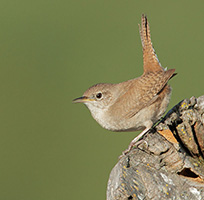Incubation: Heating Egg |
|
|---|---|

photograph of House Wren by Tom Grey |
For an egg to develop normally, it must be exposed for a considerable length of time to temperatures a few degrees below the normal 104 degrees F (40 degrees C) avian body temperature. Indeed, the ideal incubation temperature for many birds' eggs is about human body temperature, 98.6 degrees F. Almost all birds create the required temperature by sitting on the eggs and incubating them, often transferring heat via a temporarily bare area of abdominal skin called the "brood patch." A few birds, like penguins, pelicans, and gannets, transfer heat through their webbed feet. A unique form of incubation is found in the turkey-like megapodes of Australia. They heat their eggs by depositing them in a large mound of decaying vegetation, which the birds have scratched together. By opening and closing the mound as needed, the birds carefully regulate the heat of decomposition, which takes the place of the parental body heat used in normal incubation. |
| On the other hand, the
embryo inside the egg is also very sensitive to high
temperatures, so that in some situations eggs must be
protected from the sun. Ducks with open nests, for example,
will pull downy feathers (originally plucked to form their
brood patches) over the nest to cover the eggs when they
leave it, providing shade if the weather is hot and helping
to retard heat loss when it is cold. Open-nesting ducks
usually have camouflage down that does not reveal the nest's
location; hole-nesting ducks have white down. Other species
may stand over the nest and shade the eggs when temperatures
rise. Killdeer and some other shorebirds soak the feathers
of their bellies and use them to wet the eggs before
shading, thus helping to cool the developing embryos by
evaporative heat loss. Embryos are less sensitive to cold than to heat, particularly before incubation has started. Mallard eggs have been known to crack by freezing and still hatch successfully. Eggs cool when incubation is interrupted, but this is not usually harmful, and few birds incubate continuously. Instead egg temperature is regulated in response to changes in the temperature of the environment by varying the length of time that a parent bird sits on them or the tightness of the "sit." For instance, female House Wrens (which incubate without help from the males) sat on the eggs for periods averaging 14 minutes when the temperature was 59 degrees F (15 degrees C), but an average of only 7.5 minutes when it rose to 86 degrees F (30 degrees C). Many birds apparently sense the egg temperature with receptors in the brood patches, which helps them to regulate their attentiveness (time spent incubating) more accurately. Since the embryo itself increasingly generates heat as it develops, periods of attentiveness should generally decline as incubation progresses. Attentiveness is also influenced by the insulating properties of a particular nest. Eggs are also turned periodically -- from about every eight minutes by American Redstarts to once an hour by Mallards. The turning presumably helps to warm the eggs more evenly, and to prevent embryonic membranes from sticking to the shell. |
|
| SEE:
Who Incubates?
Incubation Time. Copyright ® 1988 by Paul R. Ehrlich, David S. Dobkin, and Darryl Wheye. |
|